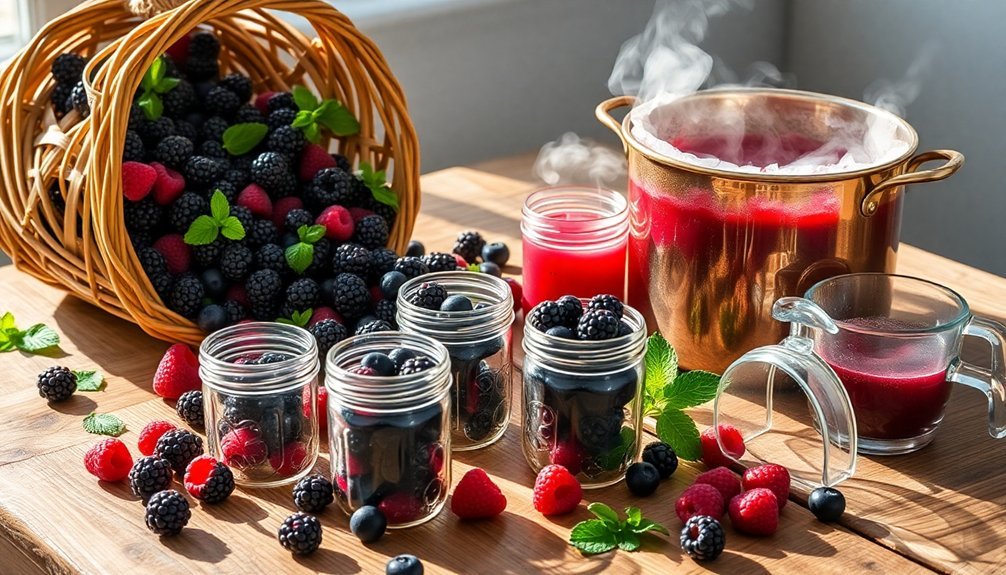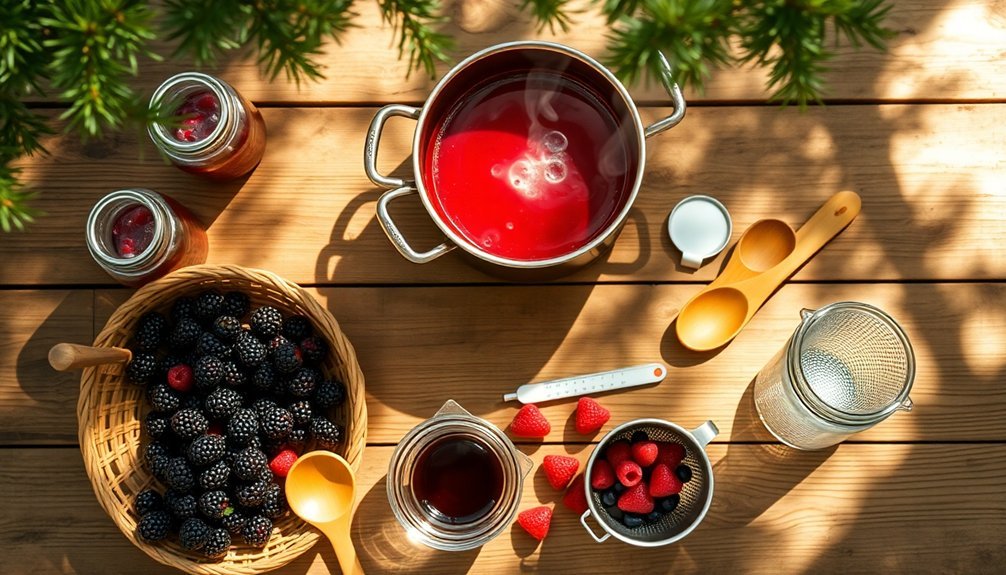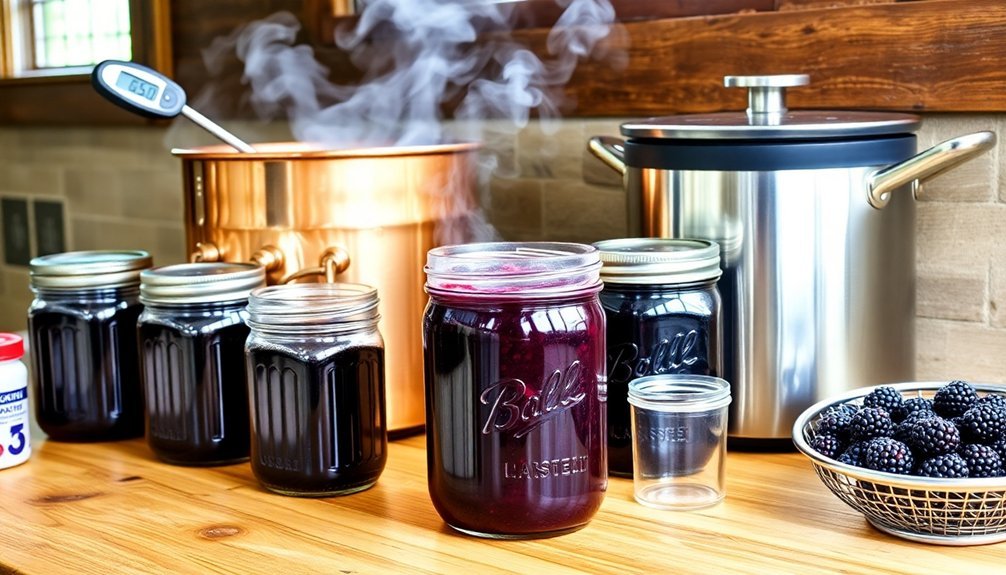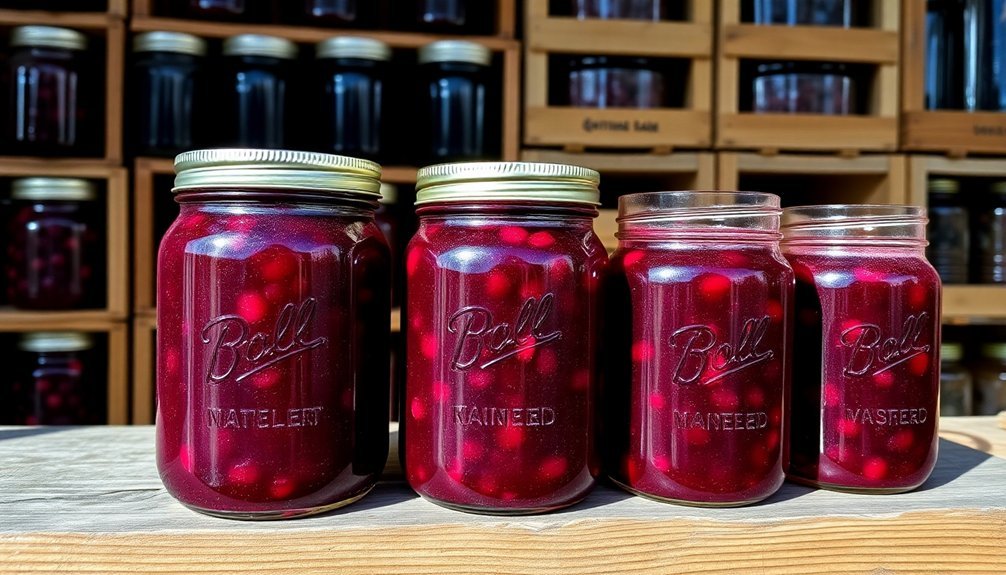Making wild berry jam starts with responsible foraging – always inform others of your plans and properly identify safe berries. You'll need collection baskets, gloves, and proper clothing for gathering. Once you've harvested your berries, sort and clean them thoroughly before combining with sugar and mashing to your desired consistency. Use sanitized glass jars, a large pot, and essential canning tools to safely preserve your creation. Process filled jars in boiling water for 10-15 minutes depending on your altitude. When done correctly, your homemade jam will last up to 18 months and reveal endless culinary possibilities.
Wild Berry Foraging Basics

Out in the wild, foraging for berries offers an exciting way to connect with nature while gathering fresh ingredients for your homemade jam. Informing others of your foraging plans helps ensure your safety while exploring. Before you head out, you'll need to research local berry species and their habitats to guarantee a successful harvest.
Make sure you're equipped with essential gear, including collection baskets, protective gloves, and long-sleeved clothing.
Proper identification is vital for your safety. You'll want to study leaf shapes, flower structures, and berry characteristics carefully. A reliable field guide or identification app can help you distinguish edible berries from toxic lookalikes.
Pay attention to the specific habitats where different berries grow – you'll find strawberries thriving in sunny meadows, while blueberries prefer acidic soil conditions.
When you're foraging, remember to follow sustainable practices. Only harvest what you need and leave plenty for wildlife. Don't collect berries from polluted areas or private property without permission.
Check local regulations about foraging on public lands, and always respect protected species. Timing your foraging trips is essential, as different berries ripen throughout the season.
With patience and careful observation, you'll develop the skills needed for successful berry foraging.
Berry Selection and Preparation
Once you've gathered your wild berries, carefully sort through them to select only the ripest, firmest fruits while removing any stems, leaves, or damaged specimens.
You'll want to create a balanced mix of berries, combining naturally high-pectin varieties like blackberries with lower-pectin types like strawberries for ideal jam consistency. Using this mix, you can create a jam that echoes the delightful taste of Giffords Maine Wildberry Ice Cream.
After sorting, gently wash your chosen berries in cold water and let them drain thoroughly before measuring and mashing them for your jam.
Selecting Prime Wild Berries
Throughout the jam-making process, selecting the right wild berries is your most vital first step. You'll want to focus on common varieties like raspberries, blueberries, blackberries, and strawberries, ensuring you can properly identify each species to avoid toxic lookalikes.
When foraging, choose locations away from areas that might be contaminated with pesticides or pollutants. Pick berries at their peak ripeness, though it's fine to include some slightly underripe ones for their higher pectin content. For proper preservation, you'll need ½ to ¾ cup sugar per cup of berries you collect.
You'll find different berries ripening throughout summer and early fall, so timing your foraging trips is essential. Look for berries in their natural habitats – forests for blueberries and bilberries, sunny fields for strawberries, and brambles for blackberries.
Once you've gathered your berries, inspect them carefully to remove stems, leaves, and any spoiled fruit. Gently wash them in cool water to remove dirt and debris, then drain thoroughly.
If you're not using the berries immediately, store them in clean containers in a cool place. Remember to handle the berries gently throughout the process to prevent bruising and maintain their quality for jam-making.
Preparing Your Berry Mix
A successful berry mix starts with careful preparation of your wild harvest. Begin by combining different varieties of berries, including raspberries, blueberries, blackberries, and strawberries. You'll want to incorporate unique flavors from berries like huckleberry, boysenberry, or loganberry if they're available. Don't hesitate to mix fresh and frozen berries when needed – bags of frozen mixed berries can be a practical supplement to your wild harvest.
Start by thoroughly rinsing your berries in cold water to remove any dirt, debris, or unwanted materials. Remove stems, leaves, and any damaged fruit, then pat them dry with a clean towel.
Next, place your cleaned berries in a large bowl and add sugar, allowing them to marinate for 10-15 minutes. This process helps release their natural juices and develops a richer flavor profile.
As you prepare for cooking, quarter any larger berries like strawberries after hulling them. Set up a heavy-bottom pot to prevent scorching, and add your zested lemon and fresh juice directly to the mixture.
You'll use a potato masher during cooking to break down firmer berries, ensuring a consistent texture in your final jam.
Essential Tools and Equipment

Before diving into wild berry jam-making, gathering the right tools and equipment will set you up for success. You'll need several categories of equipment, starting with proper canning supplies like glass jars, two-piece metal lids, and screw bands. A water bath canner or large stock pot is vital for processing your filled jars safely.
For the actual jam-making process, you'll want to have these core tools ready:
- A large saucepan or pot for cooking the berry mixture
- Heat-proof rubber spatula and wooden spoon for stirring and mashing
- Fine-mesh strainer for cleaning your berries
Don't forget your berry processing equipment – a potato masher is essential for crushing the fruit, and you might want a food mill if you're planning to make seedless jam. Keep a cutting tool handy for removing stems and damaged berries.
Proper sanitization is critical for safe preservation. You can sterilize your jars and lids in the dishwasher or with hot soapy water.
Keep sanitizer nearby for your equipment, and have clean towels ready for wiping jar rims before sealing. These tools will guarantee your wild berry jam-making process is both safe and efficient.
The Art of Jam Making
When you craft wild berry jam, you're carrying on a timeless tradition of preserving nature's bounty through cherished family recipes.
You'll need to master the interplay between sweet and tart flavors, carefully adjusting the sugar-to-fruit ratio until you achieve the perfect balance.
The most essential skill you'll develop is recognizing the exact moment when your jam reaches its ideal set point, transforming from a bubbling mixture into a spreadable preserve that holds its shape.
Heritage Preservation Through Recipes
Treasured jam recipes serve as vessels of cultural heritage, carrying stories and traditions across generations. When you document your family's wild berry jam recipes, you're not just preserving instructions – you're safeguarding a piece of your cultural identity.
These recipes often reflect the resourcefulness of your ancestors, showcasing how they transformed seasonal wild berries into delectable preserves that could be enjoyed year-round.
To guarantee your family's jam-making legacy lives on, consider these essential preservation steps:
- Record detailed notes about berry gathering locations, seasonal timing, and traditional preparation methods.
- Document any special techniques passed down through generations, including unique flavor combinations or secret ingredients.
- Capture the stories behind the recipes, such as family gathering traditions or memories of making jam with grandparents.
Balance of Sweet-Tart Flavors
While preserving family recipes captures the heritage of jam-making, mastering the balance of sweet and tart flavors forms the heart of crafting exceptional wild berry jams.
You'll need to carefully assess your berries' ripeness, as this directly affects their natural pectin and acid content. Select a mix of ripe and slightly under-ripe berries to maintain ideal levels of both.
When it comes to sweetening your jam, you'll need to adjust sugar amounts based on your berries' ripeness. Riper berries typically require more sugar to achieve the right balance.
If you find your jam's too sweet, add a splash of lemon juice to counterbalance it. The lemon juice serves double duty by enhancing the berries' natural flavors and helping the jam set properly.
Don't hesitate to experiment with alternative sweeteners like honey or maple syrup for unique flavor profiles.
You can also add depth to your jam by incorporating complementary ingredients. Try adding citrus zest for complexity, or blend different berries together, such as raspberries with blueberries.
If your jam's too tart, a touch of vanilla extract can help mellow the flavors while maintaining the desired sweet-tart balance.
Timing the Perfect Set
At the heart of successful jam-making lies the essential skill of achieving the perfect set. You'll need to master the delicate balance of pectin, sugar, acid, and heat to transform your wild berries into perfectly gelled preserves. Understanding the chemistry of setting will help you avoid common pitfalls like rock-hard or syrupy results.
The key stages you'll need to watch for are:
- Initial heating – Add sugar only after your berries have softened, stirring frequently to prevent sticking and guarantee proper dissolution.
- Rapid bubbling and foaming – Reduce stirring once the sugar's dissolved to allow moisture evaporation.
- Final cooking-down – Monitor closely for signs of setting, watching for changes in bubble appearance and glossiness.
Your cooking time will vary depending on the pectin content of your wild berries. High-pectin berries like blackberries will set in about 5 minutes, while low-pectin varieties might take up to 30 minutes.
For the most reliable results, use a thermometer to identify the gel point. When you've reached the proper set point, remove your jam from heat immediately to prevent overcooking and maintain the fresh berry flavors.
Safe Canning Methods

For successful wild berry jam preservation, proper canning methods are essential to assure food safety and prevent spoilage.
Start by preparing your canning environment with a boiling water canner and ascertain your jars are covered by at least 1 inch of water. While you're heating the jars in simmering water, wash the lids in warm soapy water and set the bands aside.
When you're ready to fill the jars, ladle your hot jam into the heated jars, leaving a ¼ inch headspace. You'll need to wipe the rims with a damp cloth and center the lids before applying the bands fingertip-tight.
Place your filled jars in the boiling water canner and process them for 10 minutes at sea level, or 15 minutes if you're above 6,000 feet.
After processing, let the jars stand in the water for 5 minutes, then remove them to cool on a towel for 12-24 hours. Don't disturb them during this time.
Once they're cool, check the seals – the lids shouldn't flex when pressed. Store your properly sealed jars in a cool, dark place, where they'll maintain peak quality for up to 18 months.
Creative Uses for Berry Jam
Berry jam's versatility extends far beyond the traditional breakfast toast. You'll find countless ways to incorporate your homemade wild berry jam into both sweet and savory dishes. From elegant desserts to breakfast favorites, your wild berry preserve can transform ordinary recipes into extraordinary treats.
- Start your day by spreading jam on warm, buttery croissants, or elevate your breakfast by adding it to American-style pancakes. For a more substantial morning meal, you can stir it into semolina pudding or use it as a filling in breakfast pastries.
- Create delectable desserts by using your berry jam in classic Victoria sandwiches, jam tarts, or crumble squares. You can also transform it into a smooth dessert sauce by mixing it with milk and confectioners' sugar, perfect for drizzling over ice cream.
- Think outside the jar by incorporating jam into savory dishes. You can use it as a glaze for meats, combine it with cheese for unique sandwich fillings, or create show-stopping picnic treats like macaroon traybakes.
Don't forget simple pleasures like filling puff pastry turnovers or adding a dollop to your favorite scones with clotted cream.
Storage and Shelf Life

Preserving your wild berry jam's freshness and flavor depends on proper storage techniques and understanding its shelf life. To maintain peak quality, store properly sealed, canned jars in a cool, dark place on your pantry shelf, away from direct light. You'll need to refrigerate your jam immediately after opening, regardless of how it was initially stored.
| Storage Method | Shelf Life | Storage Conditions |
|---|---|---|
| Canned (sealed) | 18 months | Cool, dark pantry |
| Refrigerator jam | 2-3 weeks | Refrigerator (40°F) |
| Freezer jam | 6 months | Freezer (0°F) |
| Opened jar | 3-4 days | Refrigerator (40°F) |
For the longest shelf life, guarantee you're using sterilized jars and equipment during preparation. If you're making uncooked jam, store it in the refrigerator or freezer, as it won't be shelf-stable. Always use clean utensils when serving to prevent contamination, and check for signs of spoilage before consuming. While industrial jams can last up to two years unopened, homemade versions are best enjoyed within their recommended storage periods to guarantee the best taste and food safety.
Frequently Asked Questions
Can I Mix Frozen and Fresh Berries When Making Jam?
Yes, you can mix frozen and fresh berries when making jam. They're completely compatible, and the frozen berries' softness actually helps create a smoother texture. Just make sure to thaw the frozen ones first.
What Causes Jam to Crystallize and How Can I Prevent It?
Your jam can crystallize due to excess sugar, undissolved granules, or improper cooking. You'll prevent this by measuring precisely, dissolving sugar completely, cooking at proper temperatures, and avoiding agitation during cooling.
Is It Possible to Make Jam Without Adding Any Sugar?
Yes, you can make jam without added sugar by using naturally sweet berries and alternative thickeners like chia seeds or pectin. You'll need to follow proper canning methods since sugar won't act as a preservative.
Why Does My Homemade Jam Sometimes Separate in the Jar?
Your jam separates because of density differences – fruit pieces are lighter than syrup and float up. You'll notice this more with strawberries. Don't worry though, it's common and doesn't mean your jam's spoiled.
Can I Reprocess Jam That Didn't Seal Properly the First Time?
Yes, you can reprocess unsealed jam within 24 hours. Just reheat it, fill clean sterilized jars, and use fresh lids. Remember that reprocessing may affect texture and setting properties of your jam.
In Summary
You'll find making wild berry jam both rewarding and delicious. Once you've mastered the basics of foraging, selecting, and preserving berries, you'll have jars of homemade goodness to enjoy year-round. Don't forget to label your jams with the date and berry type, and store them in a cool, dark place. Share your creations with friends and family – they'll appreciate the natural flavors of your forest-to-jar preserves.





Leave a Reply